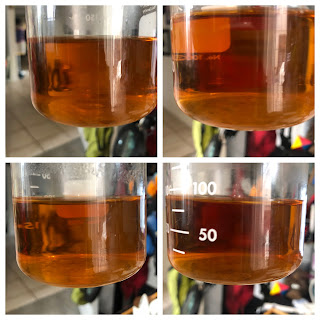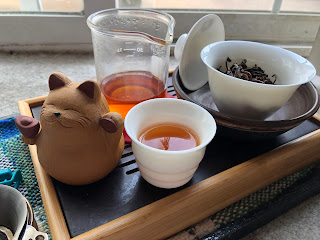Tea Session: Ultra Violet
This tea is from the West China Tea Company tea subscription box that I got this month. I try to get taste as many teas from my subscription boxes as possible. Sometimes, I can only do it on the weekends! But this one intrigued me, so I put it high on my list. ...
- Tea: Ultra Violet from West China Tea Company
- Type: Red / Black
From the WCT website:
Ultra Violet (紫外紅茶, Zǐ Wài Hóng Chá, "Ultraviolet Red Tea") - This tea is made from the leaves of the Zǐ Juān 紫娟 (“Purple Grace”) varietal of the Pu'er tea plant. Prized for its exquisite color, medicinal qualities, and powerful, euphoric Qi, this tea takes on a warm and sensual dimension when oxidized in the style of Sun-Dried Red. This tea has a musky aroma with notes of fresh red grape skin and a sweet and refreshing flavor reminiscent of dark berries and plum.Recommended Brewing: 209F 4-7 seconds
(WCT puts their recommended guidelines on their packaging. You won't find this on their website)
Tea Session Information
When I sniffed the dry leaves in the bag, there was definitely the smell of puerh.....which given the varietal is of a puerh, it makes sense. But I did have to double check the bag to make sure I didn't grab one of the puerhs that WCT sent to me.
- Teaware: 110 ml Gaiwan
- Water Amount: ~ 100 ml
- Tea Amount: 5.4 grams.
- Brewing Temperatures: 200 - 208 F
- Time (seconds: 10s, 25, 40, 60, 120
- High notes of the aroma: The lid of the gaiwan smells of sweet puerh
- Low notes of the aroma: The leaves smell of dried fruit & puerh.
- Leaves: The leaves are slow to open, and never fully open even after the 5th infusion
Figure: Leaves of Steeps 2-5 -- Top Left (#2); Top Right (#3), Bottom left(#4), Bottom Right (#5)
- Broth: The color of the broth is consistent throughout the individual infusions; remaining a nice amber color throughout.
- 1st infusion: 10 seconds. This is very mild. There is an undertone of puerh flavors with a tiny hint of pluot/plums. The finish is dry with a juicy astringency. The viscosity is a bit thin, but at 10 seconds, it's to be expected.
- 2nd infusion: 25 seconds. The broth starts off sweet with an increased viscosity from the first infusion. The sweetness is of grape. It still has a juicy astringency at the end.
- 3rd infusion: 40 seconds. Initial taste of sweet dried fruit with mild notes of puerh. This has a dry finish with that juicy astringency. I can feel the warmth in my throat after drinking the cup.
- 4th infusion: 60 seconds; the initial flavors are sweeter than previous. I can really taste the fruit and the flavor of puerh is an undercurrent. The hui gan is still there.. The finish isn't as dry. It's more viscous than others, but not by much.
- 5th infusion: 120 seconds; The viscocity is still thin, and the overall sweetness and flavors are diminishing, but the hui gan is still present.
Figure: Tea Broth -- Top Left (#2); Top Right (#3), Bottom left(#4), Bottom Right (#5)
Second Session
I wanted to sit with this tea for a while, so went for a second session the next day, this time, using my turtle gaiwan to do a session with this tea. I also did a chazao style brewing (where I crushed a tiny bit of the amount of the leave before steeping.
I lowered the temperature slightly to about 195, and the first steep was at 20seconds adding approximately 10 seconds afterwards.
This gave me a much sweeter and viscous tea. The flavor notes were still vaguely puerh, but it was much sweeter overall. Hui guan is much more present in the early steeps. It still gave out around 5 steeps, but the first few were much better than the gaiwan.
Summary
There are a lot of puerhs that I've found to be "introductory" puerhs, but THIS tea? It's like a proto-puerh. It's got some decent sweet / dried fruit flavors to it. It's like a red tea with a very mild hint of puerh flavor notes.
There's a nice hui gan (called "returning sweetness", but more like the afternotes of the tea). It's a a dry finish with a juicy astringency at the end. I can feel the cha qi in my throat after drinking it. The initial ru kou 入口 ("first impression") of the tea is very good with a mild sweet/dried fruit flavor.
My only gripe with this tea is that the soup is thinner / less viscous than I would like if brewed straight gongfu style. I've noticed this about some of the teas that are oxidized by the sun (like Sun-Dried Reds) versus being heat dried. The middle steeps are probably some of the better ones for most sun-dried teas, and this tea isn't an exception. Chazou style (with a tiny bit of crushed leaves) gave me a little bit more viscosity and the hongni Yixing gaiwan that I used made it slightly better.
Overall, I enjoyed it, and it'd be a good work daily drinker with enough interesting flavor notes to keep me interested, but not so much complexity as to distract me during work






Comments
Post a Comment